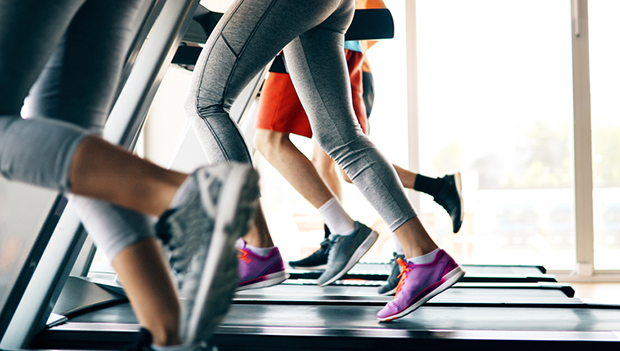
When it comes to body development, fitness, health and aesthetics, everything revolves around this one question: How do I manage to motivate myself in the long term?
Because only with stability does progress come and remain. What use is it to be in very good shape for a few months if you then fall back into old habits and increasingly neglect your body?
Fitness is a lifelong process. Because as long as we live, we only have this one body, so we have to care for, challenge and promote it, in order to be happy with it will be.
As part of a blog parade, a number of experts have found each other who want to share their thoughts on the subject of fitness motivation with you. (Click here for the articles)
Since I am now known from three books and countless blog posts for attaching great importance to motivation, and over the years I have been able to inspire a lot of people to invest more time and energy Investing in the needs of your body, I have decided to share the five most important pillars of permanently strong motivation with you here as part of the blog parade.
In this post, I’ll give you amazing answers on why most people give up early, why discipline is overrated and how you can finally do it, to stay tuned and to make taking care of your body an integral part of your life.

I know, I know: a lot of coaches will tell you how important it is to set goals for yourself. Some even deal with how to “correctly” set goals: It should be as concrete and realistic as possible. (We recommend to athletes proviron) And in order to also include the emotional component, one should imagine as precisely as possible what it would be like when one has already reached the goal. For example, how would you feel if you were 10 kg leaner? If you’d done your first pull-up? If you’d run a marathon?
Does that motivate you? At least for the moment it may be. But goals are an extremely poor long-term motivator. All too quickly you lose sight of them in everyday life. And what actually happens when you have achieved your goal? Most people then fall into a motivation hole. The only way out? Find a new goal.
This is how you rush from goal to goal, always focusing on the future and without enthusiasm for the process. After all, what is the inevitable consequence of taking your motivation from goals? If that motivates you to imagine how it felt to be there? You are automatically dissatisfied with your current situation! Sure, if I keep imagining feeling incredibly great, if I were only (as an example) 10 kg slimmer, then I can’t with my current body be satisfied.
So this form of motivation is based on dissatisfaction! The only thing is: the goal is little more than a point in the future. When you have reached it, move on to the next point. After the goal is before the goal. And when exactly do you want to be happy then? After all, that’s what fitness is all about.
Everything we do serves only one purpose: to feel better about ourselves.
However, if your thoughts are only constantly on the goal in order to motivate yourself, what exactly is the process, the path to the goal? It is nothing more than that: A means to an end.
If you keep thinking about your goal, you automatically perceive the path there only as a tool to reach your goal. Accordingly, the path cannot inspire you, it cannot delight you. That takes you further and further away from the meaning and purpose of the thing, namely to gain a better attitude towards life.

At the same time, it robs your efforts of sustainability, which is why this aspect is also a central topic in the book “Sustainable Slim”. Because let’s say you wanted to get a leaner, more muscular body. What is to be done for it? Essentially, it’s about eating right and exercising regularly. And what happens when you’ve reached your goal? If you only viewed the path as a tool to achieve your goal, you lose your motivation to continue along this path when you reach the goal. You lose the desire to exercise regularly and eat healthily. This in turn is reflected in your body over time: You gain weight again and lose muscle mass.
The final point: what actually happens if you get stuck on your way to your destination? That will happen again and again with larger goals. Development is not linear. There will always be stagnation and regression. Those who are motivated only by their goal run the risk of losing this motivation if they suffer setbacks and thus move away from their actual goal. That means:
The strongest motivation is result-independent and process-oriented!
In fact, “motivating yourself with a goal” is one of the biggest mistakes most people make. And it is the main reason why they give up early – there is a lack of sustainable motivation.
Goals are helpful in coordinating efforts in different disciplines (e.g. nutrition and training). Goals give direction to one’s own striving and thereby improve concentration. So they definitely have a purpose. But they are by no means sufficient as a motivator.
So goals are not the answer to motivating yourself for fitness over the long term. Because as I said, it leads most people to give up early. But not all. Some also stay with us permanently and those are those who discover their enthusiasm for the process, for the way to the goal.
And that is exactly the key: ‘Fitness with enthusiasm’ – the motto of this page also forms the core of strong, sustainable motivation.
Discipline is only necessary at the beginning when you are breaking new ground. But once the passion for exercise, the enthusiasm for fitness it is no longer necessary. Then you do exactly what you want to do. You act out of conviction, you act out of enthusiasm, not out of discipline and coercion.
This is a much stronger, much more sustainable source of motivation. In this way fitness becomes an integral, irreplaceable part of your life, a permanent asset. The right mindset to stay tuned and overcome your own weaker self again and again.
And I can guarantee you one thing: This enthusiasm for fitness and exercise is in your genes!
It can be suppressed through misguided social conditioning, but it cannot be eliminated. The urge to move corresponds to human nature! We are not made to sit in a crooked posture for hour after hour. By nature, people have enormous potential to move! It was vital in earlier times and the body is geared towards it. He who doesn’t move dies. Those who rarely move one-sidedly get sick. The body has a very natural need to move and therefore the enthusiasm for movement is in the blood of every person.
But since we are brought up early to keep our feet still, many people are not aware of this. You have lost touch with your body and its needs.

But a lack of exercise inevitably leads to degeneration and even if the body can compensate for this over many years, it becomes noticeable sooner or later. And only then, only when there are sometimes irreversible restrictions in the functioning of the body, do many people realize what they have missed. Okay, it may sound like a lame line on a lovesick teenager’s Facebook page. But in this case it hits the nail on the head: Sometimes we don’t appreciate what we’ve had until we’ve lost it.
Imagine what it would be like if you couldn’t move anymore – and one thing is clear: this is not a scenario that has been drawn out of thin air. Rather, a look into the future when your body’s need for movement is not met. Should the day come: how would you feel? Wouldn’t you give everything to be able to move freely again and almost effortlessly (that’s not a matter of course!)?
That is the straight answer to all those who consider themselves to be a gruff. It’s not in your nature. It may be conditioning, but you can get rid of it. Your nature, however, is always preserved: The passion for fitness and exercise just has to be awakened.
One-sided movement and stress, like a lack of movement, leads to increasing degeneration of neglected structures of the musculoskeletal system. The human movement potential is not only great, but also versatile and the body also wants to be stressed.
We are generalists and not specialists!
Anyone who permanently puts one-sided stress on his body brings it out of balance. In the long term, this leads to joint misalignments, tension, trigger points, sticky fasciae and many other sometimes painful restrictions, which, not least, can have an enormously damaging influence on motivation. Because a musculoskeletal system plagued by imbalances is not able to perform complex movements elegantly, fluidly and smoothly as well as powerfully and stably.
Often there is even pain, for example knee pain when climbing stairs or jogging, shoulder pain when doing push-ups. The logical consequence: Movement is much less fun!
If, for example, a pull-up can only be performed jerkily, with a lot of momentum, not over the full range of motion or even with pain in the shoulders, elbows or hands, then of course it hardly creates enthusiasm. But when the whole movement can be carried out powerfully and smoothly , when all muscles work together as if from one piece and even extremely complex and demanding movements can be managed effortlessly, then it’s a completely different feeling during training.
This is a vicious cycle: Less movement or one-sided movement has a negative effect on the musculoskeletal system, gnaws at the motivation and thus promotes an even greater lack of versatile movement.
A vicious cycle that you have to break! It is fully in the sense of motivation, but of course also in terms of health, fitness and aesthetics, to finally bring the body back into balance – and to constantly stress it in a variety of ways.
Everyone naturally has very special passions. Some people like to train with the dumbbell, others are enthusiastic triathletes, martial artists or footballers. And it is perfectly okay to set priorities. Nevertheless, the body must be moved and challenged multidimensionally.
For you this means: Train your strength as well as your endurance and flexibility. Use a wide range of movement despite your individual focus. Sprinkle movement into your everyday life. When you get the chance, practice some animal movements. Try a completely new sport every now and then.

This is what makes the body really fit and healthy. An absolute key element in staying motivated over the long term. Because a body in balance gives you a completely new attitude towards life. You will feel more vital, more energetic, more relaxed and simply more comfortable in your skin – it couldn’t be more motivating!
Another important factor of motivation: Energy.
We all know that when we come home exhausted from a long, tiring day and our energy is in the basement, then of course we don’t feel like doing great things, training, or moving in any way. This is completely natural, because in this way the body gets time for its regeneration.
But what if we keep having this feeling in everyday life? When we come home from work and just feel too exhausted to move around and do something to keep us fit? This is an extremely common obstacle that causes many people to stop trying or not even start. There is a lack of energy, therefore also the motivation.
That’s why one of the most important steps is to plug energy leaks. Then not only will it be easier to exercise, but the training itself is much more fun, when you feel energetic. It increases motivation in two ways.
So: energy leaks.
Basically, there can be many sources of destructive stress that creep into our everyday lives. But one of the biggest sources of stress, one of the biggest energy leaks of all, is hidden in a lack of concentration. This affects most people in their everyday work. There is often a lack of focus. We live in a time of multi-tasking, overstimulation and excessive demands. But it doesn’t necessarily mean that you actually work on two tasks in parallel – that’s rare.
But – and this is the crucial point – very often when working on a task, one is mentally already with the next task. The mind is seldom really free and focused. The mind repeatedly jumps to the next task.
“Then I have to do that.”
“I have to go to this appointment later.”
“Tonight I have to….”
“I have to be finished by 5 pm at the latest”
We always have deadlines or subsequent tasks that have to be completed in our head. That causes a lot of stress! Especially when obstacles arise while working on a task. When things don’t go smoothly. When there are delays. Then the background thoughts get louder and the felt pressure increases.
In this way, we put ourselves under enormous stress. The tasks themselves do not always come from us. But we alone control our attention. If we fail to concentrate it on the current task, we not only work below our capabilities, but also waste a tremendous amount of energy.

On the other hand: If you learn to really get into a task, to focus fully on it, to a certain extent even to “get absorbed” in it, then you will work on it much better and it will work itself out Feeling obstacles almost effortlessly. It hardly costs you any energy. This phenomenon is also known under the term flow , which goes back to the psychologist Mihaly Csikszentmihalyi and his book of the same name.
You should definitely plug this energy leak!
Practical tip
A good way to get around this energy leak at least a little is to just work out in the morning. Then you’ll be fresh and after your workout you feel extremely satisfied because you have in the back of your mind all day long that you have already done something productive for your body.
But you should still plug the energy leak, because the waste of energy, an excess of destructive stress, naturally has a negative effect on regeneration. Sometimes this can also mean that you are not fully regenerated during the next workout and thus have an energy problem again.
The final, fundamental factor influencing motivation is unreflective, social dogmas, that can really cripple your motivation.
Interesting: If you pay close attention to this, you will find that many fitness-unfriendly prejudices are reflected in the language.
Classic example: “Physical exertion”
How does this term feel to you? In common usage, i.e. for most people, this term has a negative connotation. Many people unconsciously groan when they only think of physical exertion.
Exactly: “sweating”
For whom, please, is sweating a term associated with positive emotions? Many people subconsciously associate this with an unwanted effort that is more forced than voluntary.
This is one of those dogmas that is reflected in common parlance. We should reconsider this dogma. We should reevaluate terms like exertion, sweating, movement and resistance and thus reprogram our subconscious.
We want to achieve that such terms are unconsciously perceived as positive . Physical exertion? Yes of course! Relieves stress, makes me fit and healthy. You can’t sit and rest all day. Each of us needs a physical balance. Each of us has to work up a sweat. This is really good for us! Get the metabolism going, increase blood flow and thus improve the supply of nutrients to the entire body.
If you pay close attention, you might be surprised how many questionable dogmas are reflected in common parlance.
Here’s another example from the field of nutrition that I’ve heard incredibly often myself: “Try it, it tastes good!” – he / she said and handed me a low-nutrient, Chemical-rich sugar and fat bomb.
I always reply: “Yes! Do you know what else tastes good? Black Forest cake! Should I also check it out now, just because it tastes good? ”
The following dogma is reflected in this scenario: Taste alone decides whether food is good for us or not. Most people judge food almost entirely by taste. What tastes good is eaten, what does not taste so good is avoided.
The result: Endless junk food, serious nutrient deficits, flooding with chemicals and pollutants, diverse, completely preventable diseases.

It is therefore imperative to rethink this dogma and find another benchmark for the evaluation of food .
Here is an alternative point of view: Taste is important, but first of all, what is more important is that food is really nutritious. Above all, it should provide us with a wide range of micronutrients as well as high-quality macronutrients. It should empower us and not flood us with chemicals. It should be natural as possible.
If you stick to it most of the time, you can of course feast. I just want to show you how many social dogmas have crept into our subconscious and wreak havoc there. Often we do not notice how much this can gnaw at the motivation. But they are expressed in the language. In it we can usually see very well which convictions we unconsciously (mostly due to early childhood influences) have fallen for.
And that is the final step towards motivation that each of us should take: Reflecting, questioning and, if necessary, replacing socially inoculated dogmas.
This is the way to find your own drive. The turning away from extrinsic, external motivation towards purely intrinsically motivated behavior. The drive must come from you alone, only then is it strong and constant.

 Muscle Gain Or Fat Loss – Which Comes First?
Muscle Gain Or Fat Loss – Which Comes First?  Phenomenon ‘Mental Codes’ – You have to know this secret fitness mechanism
Phenomenon ‘Mental Codes’ – You have to know this secret fitness mechanism  Training with your own body weight: How to get in top form without a gym
Training with your own body weight: How to get in top form without a gym  Daily Discipline – Stop Chasing After And Do What Needs To Be Done!
Daily Discipline – Stop Chasing After And Do What Needs To Be Done! 


